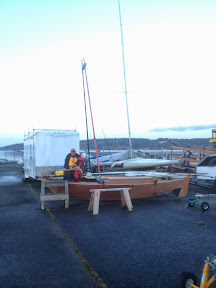On Monday we moved the boat from backyard testing to Lake Washington trials. After assembling the boat (in just under an hour), we ceremoniously poured some Alaskan Amber over her bows and officially named her Manu-o-ku. She is named after the Hawaiian word for the White Tern — a beautiful bird with the habit of flying out to sea to feed during the day before returning to land for the night. So we will travel with a navigator bird flying with us, our minds remembering our families as we voyage north, braving the Pacific but never straying too far from land.
Thanks to Acting Director Nino Johnson and the Board of Sail Sand Point we now have a great spot to store the boat close to the water this winter/spring. We really appreciate their sponsorship, as well as the great summer sailing educational opportunities they provide to Seattle (and especially Scott’s kids).




While we’re enthusiastic about training in Puget Sound later this year, the Lake affords many opportunities that will let us learn about our boat and our selves. The lack of tides removes a confounding variable when we gather performance data on how in Manu-o-ku move and we grow stronger. The extra-chilly surface temperature lets us test our gear in conditions that are thermally worse than what we’ll find in Dixon Entrance. And less wintertime traffic will let us practice traveling at night and in flat-water conditions without the risks and complications of busy Puget Sound.
